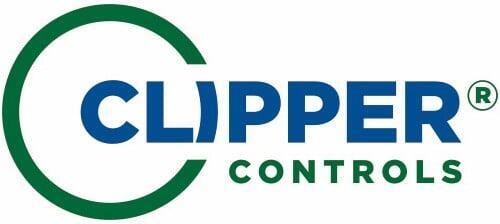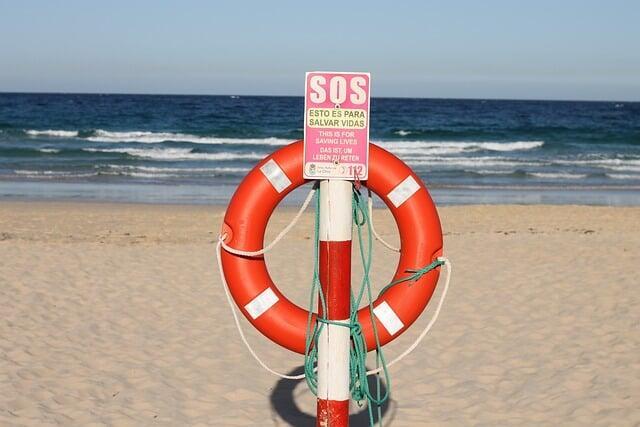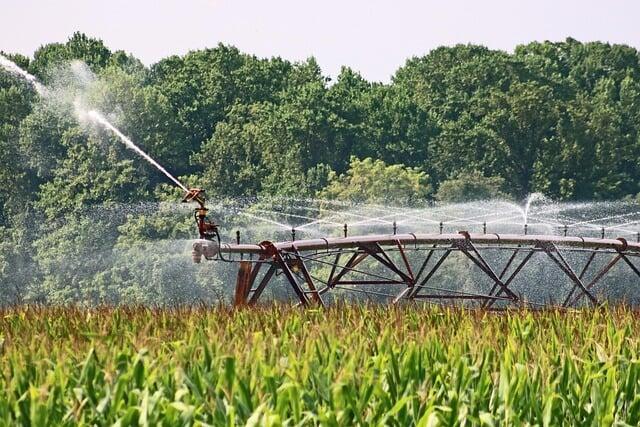Irrigation & Irrigation Canal Applications
Application Overview
Efficient irrigation and irrigation canal management require precise monitoring and control to optimize water usage, reduce waste, and ensure compliance with environmental regulations. Modern irrigation systems integrate flow measurement, level monitoring, and automated control solutions to maintain optimal water distribution across agricultural fields, golf courses, and municipal landscapes. Accurate flow meters and level sensors help prevent overwatering or under-irrigation, improving crop yields and landscape health while conserving valuable water resources. Additionally, real-time data collection and remote monitoring capabilities enable operators to respond quickly to changing conditions, reducing the risk of system failures or environmental impact.
In water canal applications, reliable instrumentation is essential for monitoring water levels, flow rates, and water quality in reservoirs, rivers, and stormwater systems. Properly designed control systems help manage runoff, prevent flooding, and ensure compliance with regulatory discharge limits. Advanced telemetry and SCADA integration allow for remote operation and predictive maintenance, minimizing downtime and operational costs. As climate variability increases, accurate and responsive control solutions become even more critical in managing water distribution and mitigating the effects of droughts and heavy rainfall events.
How Our Products Support Your Industry
Key Applications and Solutions
Flow Monitoring and Measurement
Effective flow monitoring and measurement are critical components of irrigation and water canal management, ensuring precise water distribution, conservation, and regulatory compliance. In irrigation systems, accurate flow measurement helps optimize water usage, prevent overwatering, and maintain the health of crops while reducing operational costs. In large-scale applications such as irrigation canals, proper flow monitoring prevents water loss, improves efficiency, and supports sustainable resource management. Advanced flow monitoring technologies provide real-time data that enable operators to adjust water allocation based on demand, seasonal changes, and environmental conditions.
Applications of Flow Monitoring and Measurement in Irrigation and Canals
Flow measurement plays a crucial role in managing water distribution for municipal and agricultural irrigation, as well as large-scale agricultural irrigation canal networks. Proper monitoring ensures that water is allocated efficiently, reducing waste and improving overall system performance. Key applications include:
- Irrigation System Management – Flow meters help regulate water delivery to fields, ensuring consistent application rates and preventing overuse that can lead to soil erosion or waterlogging.
- Canal Flow Regulation – Monitoring flow rates in irrigation canals ensures optimal water distribution across agricultural regions, preventing imbalances and unnecessary loss of water through seepage or evaporation.
- Water Rights Compliance – Accurate flow measurement is necessary to adhere to water allocation agreements and legal requirements, ensuring fair and sustainable water distribution among stakeholders.
- Pumping Station Optimization – Flow meters integrated with automated pump control systems help maintain efficient operation, adjusting flow rates in response to changing demand and reducing energy costs.
- Leak Detection and Water Loss Prevention – Continuous flow monitoring helps identify leaks or unauthorized usage in irrigation networks, minimizing losses and improving overall efficiency.
ClipperView Flow Monitoring System
ClipperView is a cloud-based flow data management platform built to support the unique needs of irrigation districts, canal operators, and agricultural water managers. Compatible with ISCO Signature, Duratracker, and common flow measurement technologies—including area velocity, ultrasonic, bubbler, and LaserFlow sensors—ClipperView provides continuous, real-time visibility into canal flow rates, gate operations, and water delivery.
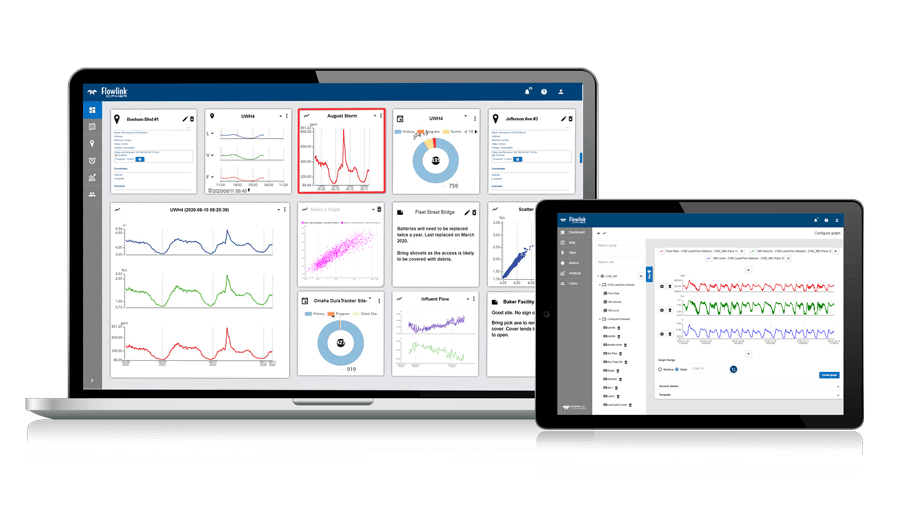
Designed for Irrigation Water Management
Real-Time Canal Flow Monitoring
Track flows at diversion points, lateral branches, and turnout gates—without needing to travel on-site or perform manual downloads.Accurate Water Allocation and Delivery Tracking
Monitor and record flows to ensure proper delivery to growers, enforce allotments, and support billing or cost-share agreements.Supports Open Channel Flow Measurement
ClipperView works with area velocity meters and level sensors ideal for non-pressurized canals and open water structures.Remote Access From Any Device
Field crews, water masters, and administrators can view system data anytime via mobile, tablet, or desktop.Simplified Deployment
No servers or IT support required—just connect your instrumentation and start monitoring. Cellular connectivity available.Long-Term Trend Analysis
Review flow history across seasons to support planning, maintenance scheduling, and water conservation efforts.
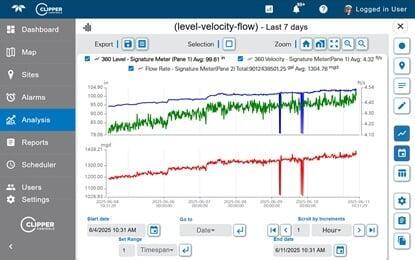

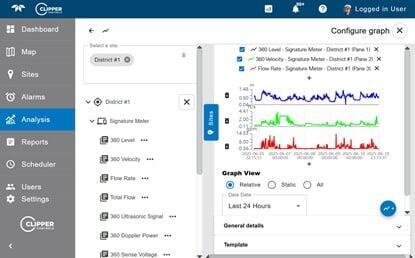
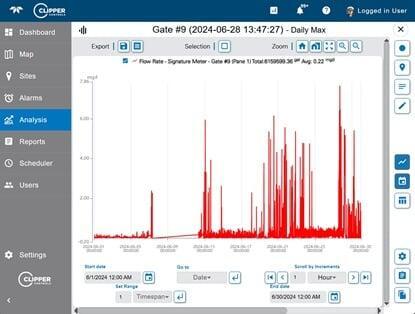
Talk to an Expert About ClipperView
Key Purchasing Considerations
Selecting the right flow monitoring equipment for irrigation and canal systems requires careful evaluation of various factors to ensure reliability and long-term performance. Considerations include:
- Meter Type – Different flow meters, such as electromagnetic, ultrasonic, and propeller meters, offer varying levels of accuracy and suitability depending on factors like water quality and flow rate.
- Durability in Harsh Environments – Equipment must withstand fluctuating water levels, debris, sediment, and exposure to outdoor elements common in irrigation systems.
- Installation Requirements – Flow meters should be compatible with existing infrastructure, whether installed in open channels, pressurized pipelines, or large-scale canal networks.
- Remote Monitoring and Data Integration – Advanced flow meters with telemetry capabilities allow real-time monitoring through SCADA systems, enabling remote operation and automated alerts for flow deviations.
- Accuracy and Maintenance – High-precision measurement ensures compliance with water allocation regulations, while low-maintenance designs reduce long-term operational costs.
Water Level Monitoring
Accurate water level monitoring is essential for optimizing irrigation efficiency, managing water canal resources, and preventing water loss in agricultural and municipal applications. In irrigation systems, monitoring water levels in reservoirs, canals, and storage tanks ensures adequate water availability and helps prevent shortages or overflow. In surface water applications, such as flood control and stormwater management, real-time level monitoring helps mitigate risks and optimize water distribution. By leveraging advanced sensor technology, operators can track water levels remotely, automate pump operations, and make data-driven decisions to improve overall system performance.
Applications of Water Level Monitoring in Irrigation and Canals
Water level monitoring plays a critical role in maintaining stable water distribution and optimizing resource use in both irrigation and large-scale irrigation canal systems. Key applications include:
- Irrigation Reservoir Management – Ensures that stored water levels remain sufficient for scheduled irrigation cycles while preventing overflow and wastage.
- Canal Water Level Control – Monitoring water levels in irrigation canals allows for precise flow adjustments to optimize distribution and prevent excessive seepage or erosion.
- Pond and Storage Tank Monitoring – Helps maintain consistent water availability for irrigation systems by preventing depletion or overflow of holding tanks and ponds.
- Flood Prevention in Agricultural Fields – Real-time monitoring of canal levels can trigger automated drainage or pumping systems to prevent crop damage due to excess water.
- Groundwater Recharge Monitoring – In areas where irrigation relies on groundwater, monitoring well levels ensures sustainable water extraction and prevents overuse.
- Stormwater and Drainage System Management – Helps municipalities and agricultural operators control runoff, mitigate erosion, and comply with environmental regulations.
Key Purchasing Considerations
Selecting the right water level monitoring equipment is crucial for achieving accurate measurements and maintaining efficient water management. Key factors to consider include:
- Sensor Type – Options include ultrasonic, radar, pressure-based, and float sensors, each suited for different environmental conditions and accuracy requirements.
- Accuracy and Sensitivity – High-precision sensors are necessary for detecting even minor level fluctuations, especially in applications requiring tight control over water distribution.
- Durability and Environmental Resistance – Equipment should be resistant to sediment buildup, chemical exposure, and extreme weather conditions common in irrigation and surface water environments.
- Real-Time Monitoring and Remote Access – Systems with SCADA integration, telemetry capabilities, or cloud-based data access allow for remote tracking and automated alerts.
- Ease of Installation and Maintenance – Simple installation and low-maintenance designs reduce operational costs and minimize downtime.
- Power Source and Energy Efficiency – Solar-powered or battery-operated options can be beneficial for remote locations without direct access to power.
Water Pressure Regulation
Proper water pressure regulation is essential for maintaining the efficiency and longevity of irrigation systems and surface water management infrastructure. In irrigation applications, maintaining consistent pressure ensures uniform water distribution, prevents equipment damage, and optimizes system performance. Without adequate pressure control, issues such as overwatering, pipe bursts, and inefficient water delivery can occur, leading to increased operational costs and resource waste. In large-scale irrigation networks and canal systems, pressure regulation helps balance flow rates, maintain system stability, and ensure water reaches its intended destinations without excessive loss or variability.
Applications of Pressure Regulation in Irrigation and Canals
Pressure regulation is crucial in both localized irrigation systems and large-scale canal applications. Key applications include:
- Drip and Sprinkler Irrigation Systems – Ensuring consistent pressure prevents uneven water distribution, which can lead to dry spots or overwatering, affecting crop health and water conservation.
- Pump Stations in Irrigation Networks – Pressure regulation in pump stations helps maintain steady flow rates across extensive irrigation networks, reducing energy consumption and preventing pressure surges that can damage infrastructure.
- Canal Water Distribution – Proper pressure management in irrigation canals ensures that water is evenly distributed across different zones, reducing water loss through seepage and evaporation.
- Filtration and Treatment Systems – Many irrigation systems incorporate filtration units to remove debris and sediments; consistent pressure helps maintain filtration efficiency and prevents clogging.
- Valve and Pipeline Protection – Pressure regulation devices help prevent excessive pressure that can lead to pipe bursts, leaks, or equipment failure, reducing maintenance costs and extending system lifespan.
Key Purchasing Considerations
Choosing the right pressure regulation equipment is critical for maintaining an efficient and reliable irrigation or water canal system. Important factors to consider include:
- Pressure Range and Accuracy – Devices should be capable of maintaining pressure within the optimal range required for the specific irrigation or canal system.
- Durability and Corrosion Resistance – Equipment must withstand exposure to chemicals, sediments, and varying environmental conditions common in agricultural and canal applications.
- Type of Pressure Regulator – Options include inline pressure regulators, adjustable valves, and automatic control valves, each suited for different system needs.
- Flow Rate Compatibility – The regulator should be selected based on system flow rates to ensure efficiency without restricting water supply.
- Integration with Control Systems – Advanced regulators with SCADA or remote monitoring capabilities allow for automated adjustments and real-time system optimization.
- Maintenance and Reliability – Low-maintenance designs with self-cleaning mechanisms or durable diaphragms reduce downtime and operational costs.
Pump & Valve Automation
Automating pumps and valves in irrigation and water canal management enhances efficiency, reduces manual intervention, and optimizes water distribution. In agricultural irrigation, automated pumps and valves ensure precise water delivery based on crop requirements, reducing waste and improving yield. In large-scale irrigation canals and municipal water systems, automation helps regulate water flow, maintain consistent pressure, and adjust distribution based on real-time demand. By integrating advanced control systems, remote monitoring, and predictive analytics, pump and valve automation improves operational reliability and resource conservation.
Applications of Pump & Valve Automation in Irrigation and Canals
Automated pump and valve control is critical for maintaining efficient water distribution in various irrigation and irrigation canal applications. Key applications include:
- Irrigation Scheduling Automation – Automating pumps and valves enables precise water delivery based on pre-programmed schedules, ensuring optimal soil moisture levels while conserving water.
- Variable Flow Rate Control – Adjusting pump speeds and valve positions based on real-time data prevents overuse, reduces energy consumption, and maintains steady flow rates in irrigation systems.
- Canal Flow Regulation – Automated sluice gates and flow control valves optimize water distribution in irrigation canals, preventing overflow and ensuring equitable water allocation.
- Remote Pump & Valve Operation – SCADA and IoT-enabled systems allow remote control of pumps and valves, reducing the need for on-site adjustments and improving response time to system fluctuations.
- Pump Efficiency Optimization – Variable frequency drives (VFDs) and automated pump controls adjust output based on demand, reducing energy costs and extending equipment lifespan.
- Emergency Shutoff and Leak Prevention – Automated valves and pressure sensors can detect leaks or pipe bursts, triggering immediate shutdowns to prevent water loss and infrastructure damage.
Key Purchasing Considerations
Selecting the right automation solutions for pumps and valves is essential for improving efficiency and reliability in irrigation and surface water management. Important considerations include:
- System Compatibility – Ensure that automated pumps and valves integrate seamlessly with existing irrigation networks, SCADA systems, and remote monitoring platforms.
- Control and Communication Protocols – Choose systems that support industry-standard communication protocols (e.g., Modbus, Profibus, Ethernet/IP) for easy integration and remote operation.
- Durability and Environmental Resistance – Equipment should be built to withstand harsh outdoor conditions, including exposure to moisture, temperature fluctuations, and sediment-laden water.
- Energy Efficiency – Look for solutions with energy-saving features such as VFDs, pressure sensors, and demand-based automation to reduce operational costs.
- Reliability and Maintenance Needs – Low-maintenance, self-diagnostic components improve uptime and reduce labor-intensive repairs.
- Power Source Options – Depending on the location, solar-powered, battery-operated, or grid-connected automation systems may be the best fit for reliable operation.
Water Quality Monitoring
Monitoring water quality in irrigation and surface water applications is essential for ensuring the health of crops, maintaining soil integrity, and complying with environmental regulations. Contaminants such as excessive nutrients, sediments, salinity, and chemical pollutants can negatively impact irrigation efficiency and long-term land productivity. Effective water quality monitoring enables farmers, irrigation districts, and municipal water managers to detect and address issues proactively, preventing damage to irrigation equipment, reducing the risk of soil degradation, and optimizing water treatment processes when necessary. By integrating real-time monitoring solutions, operators can maintain water quality standards, improve resource management, and protect the environment.
Applications of Water Quality Monitoring in Irrigation and Canals
Water quality monitoring is critical in both agricultural irrigation and canal management to ensure sustainable and efficient water use. Key applications include:
- Nutrient and Salinity Monitoring – Helps prevent excessive buildup of salts and nutrients that can harm crops and degrade soil health over time.
- Sediment Control in Canals and Reservoirs – Reduces the risk of clogged irrigation systems and ensures consistent water flow in surface water applications.
- pH and Alkalinity Management – Monitoring pH levels helps maintain optimal water conditions for irrigation, preventing damage to plants and minimizing the need for corrective treatments.
- Detection of Contaminants and Pesticide Residue – Ensures that water used for irrigation is free from harmful chemicals that could impact crop health and food safety.
- Dissolved Oxygen Monitoring – Critical for surface water systems, ensuring that aquatic ecosystems remain balanced and preventing stagnation in irrigation reservoirs.
- Real-Time Data for Compliance and Sustainability – Helps agricultural operations and municipalities adhere to water quality regulations and implement sustainable water management practices.
Key Purchasing Considerations
Choosing the right water quality monitoring equipment is essential for accurate measurements and long-term reliability. Key factors to consider include:
- Sensor Type and Accuracy – Select sensors based on the specific parameters required, such as turbidity, conductivity, pH, dissolved oxygen, or nutrient levels.
- Durability in Harsh Environments – Equipment should withstand exposure to sediment, fluctuating temperatures, and potential chemical interactions.
- Automation and Remote Monitoring Capabilities – Systems with SCADA or IoT integration enable real-time tracking and automated alerts for water quality fluctuations.
- Ease of Calibration and Maintenance – Regular calibration is necessary for accurate readings; opt for low-maintenance sensors with automated self-cleaning functions when possible.
- Sampling Method – Consider whether inline, submersible, or grab-sample sensors best suit the specific irrigation or surface water system.
- Compliance and Data Logging – Ensure that the system meets regulatory requirements and provides sufficient data storage and reporting capabilities for long-term monitoring.
Data Logging & Remote Monitoring
Data logging and remote monitoring are essential for optimizing irrigation and surface water management by providing real-time insights, improving efficiency, and reducing operational costs. By continuously collecting and analyzing data on flow rates, pressure levels, water quality, and system performance, operators can make informed decisions that enhance water distribution, prevent equipment failures, and ensure regulatory compliance. Remote monitoring enables irrigation managers and water resource operators to track system performance from anywhere, allowing for timely adjustments and reducing the need for manual inspections. With advanced telemetry and SCADA integration, data logging and remote monitoring systems improve overall water management, enhance sustainability, and minimize downtime.
Applications of Data Logging & Remote Monitoring in Irrigation and Canals
The ability to collect and analyze real-time data significantly enhances the effectiveness of irrigation and surface water management. Key applications include:
- Irrigation System Performance Monitoring – Tracks flow rates, pressure levels, and system efficiency to ensure optimal water distribution and reduce waste.
- Remote Canal and Reservoir Management – Allows for real-time adjustments of gates, valves, and pumps to maintain optimal water levels and prevent overflow or depletion.
- Leak Detection and System Diagnostics – Identifies anomalies such as sudden pressure drops or inconsistent flow rates, helping prevent water loss and costly repairs.
- Water Quality Compliance Tracking – Continuously monitors pH, turbidity, and other key water quality parameters to meet regulatory requirements and protect soil and crop health.
- Predictive Maintenance for Pumps & Valves – Detects early signs of wear or malfunction, reducing downtime and extending equipment lifespan.
- Automated Alerts and Reporting – Sends notifications for critical system changes, enabling quick responses to potential failures, leaks, or environmental changes.
Key Purchasing Considerations
Selecting the right data logging and remote monitoring solutions is crucial for maintaining efficient and sustainable irrigation and surface water management systems. Key factors to consider include:
- System Compatibility and Integration – Ensure compatibility with existing SCADA systems, IoT networks, and control devices to enable seamless data collection and automation.
- Sensor Accuracy and Data Resolution – High-precision sensors and detailed logging capabilities provide more reliable insights for decision-making.
- Connectivity Options – Choose from wired, cellular, satellite, or LoRaWAN communication methods based on the location and accessibility of the monitoring sites.
- Power Supply and Backup Options – Solar-powered and battery-operated solutions offer reliability in remote locations where direct power sources may be unavailable.
- Data Storage and Cloud Accessibility – Systems with cloud integration allow for remote access to historical and real-time data, enabling better trend analysis and reporting.
- User Interface and Ease of Use – A user-friendly dashboard with customizable alerts, automated reporting, and visualization tools improves operational efficiency.
Industry Standards & Regulatory Compliance
Water Rights, Efficiency Mandates & Environmental Regulations for Irrigation Systems
- Requires all water rights holders diverting more than 10 acre-feet per year to install certified, continuous flow measurement devices.
- Instruments must have a manufacturer’s stated accuracy of ±10% or better and be calibrated annually by an approved method.
- Requires automated reporting of hourly flow rates, total diverted volume, and sensor performance via remote telemetry.
- Encourages the adoption of automated gates, SCADA integration, and water accounting platforms to improve delivery precision and canal efficiency.
- Supports infrastructure upgrades through grant funding, with compliance tied to performance benchmarks in flow control and conservation.
- Irrigation canals must manage runoff containing sediment, fertilizers, and pesticides, which can degrade receiving water bodies.
- Monitoring systems must track water quality indicators like turbidity, nitrate levels, conductivity, and pH to support Best Management Practices (BMPs).
- Facilities participating in irrigation return flow discharges may require NPDES permits and must document treatment or mitigation efforts.
- Irrigation districts must measure and report deliveries to customers using volumetric methods supported by flow meters or calibrated flumes.
- Accuracy standards vary based on delivery volume, but all systems must be maintained, inspected, and certified regularly.
Sustainability & Reporting Standards
- State mandates often require growers and districts to document seasonal use patterns, conveyance efficiency, and delivery schedules.
- Instrumentation that supports hourly and seasonal aggregation of usage data simplifies reporting and supports eligibility for conservation incentives.
- Irrigation infrastructure near protected waterways must implement fish-friendly screens, erosion control, and low-flow monitoring to prevent harm to aquatic species.
- Some systems must demonstrate compliance with ESA (Endangered Species Act) or Clean Water Act Section 401 certifications.
- Under the Sustainable Groundwater Management Act (SGMA), surface water deliveries must be tracked to assess basin recharge and sustainable yield.
- Flow and quality data are often shared with Groundwater Sustainability Agencies (GSAs) to support basin-level planning.
Benefits of Working With Clipper Controls
Clipper Controls provides industry-leading expertise and high-quality instrumentation solutions for irrigation and canal applications. Our products ensure precise flow measurement, pressure regulation, and water quality monitoring, helping clients optimize water usage, improve efficiency, and meet regulatory requirements. With decades of experience, we deliver reliable, cost-effective solutions tailored to the needs of agricultural, municipal, and industrial water management.
By partnering with Clipper Controls, clients gain access to cutting-edge automation and remote monitoring technologies that enhance operational control and reduce maintenance costs. Our team offers expert guidance in selecting and integrating the right equipment, ensuring seamless compatibility with existing systems. With responsive customer support and a commitment to innovation, we help clients achieve long-term sustainability and system reliability.
Case Studies & Success Stories
Explore real-world examples of how our innovative solutions have helped irrigation districts, agricultural operations, and municipalities optimize water management.
Click here to read our water and wastewater case studies.

Real Results, Real Impact:
Thanks to Clipper Controls, our wastewater treatment plant improved efficiency & compliance with top-tier flow meters. Reliable solutions, great support! We recommend Clipper Controls to all our partner companies.
~ John Smith, Controls Engineer @ ABC Company
Clipper Controls helped our city upgrade water monitoring systems, ensuring accuracy & compliance. Reliable solutions & excellent customer service!
~ Nancy Patel, Procurement @ ABC Company
~ John Smith, Controls Engineer @ ABC Company
